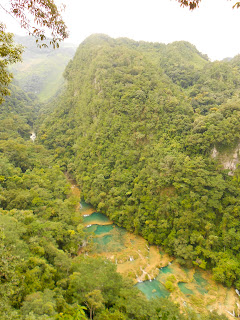I'm going to do a series of posts about Copán, since there is just so much to write about that I could never put it all into one post. Well, I could but it would be really long and someone with my attention span would never be able to read it all in one sitting...

The shuttle left Antigua at 4:30 AM. As usual, there were about 12 of us crammed into a shuttle that was only designed to fit 10. I popped in some earphones and cranked up my ipod in an attempt to power through the entire six hours without falling asleep on such a crowded seat, but that plan didn't last very long and soon enough I was snoring away on the shoulder of the middle-aged moustached man who I later learned to be from Mexico sitting next to me. This man had a particularly strange shuttle ride considering that after I stopped drooling on his shoulder and woke up and pretended that nothing had happened, the gringo sitting next to him opposite me began to sleep-cuddle with him. What he was dreaming nobody knows, but suddenly his arm jerked up and settled down over the shoulder of our moustached mexican friend (who introduced himself later as Mario). Before Mario had any time to react, this gringo began pulling him closer into a strange sleep-hug. Mario shook the arm off and this poor gringo woke up with half the shuttle giggling about what had just happened. He was so embarrassed that he decided to stay in a hotel different from the one that comes in a package with the shuttle.
When we finally arrived in Copán, we checked into our hotel and were notified that our tour had to be delayed until 2 PM because all the guides were... busy (whatever that was supposed to mean). By now I'm pretty used to things never going as planned, so I took the opportunity to get out and explore Copán a bit. It's a really nice little town - quaint, even. I ate lunch at a local comedor - some pupusas with a beet and cabbage salsa, garnachas (fried tortillas with beans, avocado, cheese, and lime), some flan de nance (nance is a bitter fruit with a big pit in the middle that is really common in Costa Rica and that I had tried a number of times but never used in flan), and a really bold cup of Honduran coffee. Can you tell by how detailed that description is that I'm really hungry right now?


Anyways, after a quick nap in the hotel Mario and I and two women from Germany who looked very uncomfortable about everything piled into the car of one of the hotel workers and drove a quick 1 km to the ruins. Mario and I shared a guide, and aside from having to spend a few minutes mentally translating some of the architectural terms that the guide was using, the tour was great - and the site is absolutely fascinating.
 |
| My guide informed me that this particular sculpture is called "Cabeza del ansiano" -- "old man's head." Really? Couldn't come up with a more creative name? |
I'll go into detail about the site's history and stuff like that in the next post, so right now I'll point out some stuff that I thought was just plain cool.
According to my guide, the above courtyard would be plugged up and allowed to fill with water during the rainy season so that, during the dry season, the wealthiest members of the city would have easy access to water. The fact that the mayans were able to do that is impressive in itself, but no mayan structure is built just for function. The mayans designed the buildings to mimic the natural world. The courtyard, when filled with water, was supposed to resemble the ocean, while the pyramid-like temple seen in the above picture represented a volcano. Also, the water would be kept at at a certain depth so that it came up to a certain spot on the structure to the left of the above picture and looked like a beach.


In the above left picture is the level to which the courtyard would be filled. Those sculptures resemble conch shells. The sculpture in the above right picture would have been located at the top of a column and would be just above the level of the water in the middle of the courtyard to look like monsters swimming around in the water. The sculpture of the dragon below would be arranged in a similar way.

The drainage system in the above right picture was used to maintain the water at the correct level.
This is a view from below of the "beach" where the surface of the water would be. It would come right up to the neck of this dude, which is supposedly some sort of water god. When this courtyard wasn't filled with water, it served as an auditorium that still has excellent acoustics. A clap from one side could be heard very clearly at the other.
This is turning into a pretty long post, so I'm going to cut it short here and continue it tomorrow, going a bit more into the history of the site and the significance of the sculptures. But before I go, here are some pics of the scarlet macaws that were flying all over the place. This is possibly one of the coolest animals ever.






















































